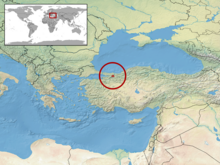Baran's Viper
| Baran's Viper | ||||||||||||
|---|---|---|---|---|---|---|---|---|---|---|---|---|
| Systematics | ||||||||||||
|
||||||||||||
| Scientific name | ||||||||||||
| Vipera barani | ||||||||||||
| Böhme & Joger , 1983 |
Baran's viper ( Vipera barani ), also barans Otter , is a kind of genuine otters ( Vipera ) within the vipers (Viperidae), which the adder is very close and for a long time been scientifically demonstrated by only a single individual. The habitat of the snake is located north of the city of Adapazari in the Turkish coast of the Black Sea . The species is named after the Turkish herpetologist Ibrahim Baran (* 1940).
features
The originally only specimen of Baran's Viper was 54 cm long. It is a completely black animal ( melanism ), with the shields of the upper lip bearing conspicuous white spots. The underside of the tail is lemon yellow.
The head is clearly separated from the rest of the body. The eyes have vertically slit pupils . Compared to other species, the snout region protrudes angularly. With the exception of the overhead shields, all shields on the top of the head are broken up into small individual scales. The nasal is almost as big as the eye and houses the nostril in the middle. Below the eyes there are two rows of under eye shields ( supraocularia ), underneath are 10 upper lip shields ( supralabialia ). The body scales are keeled. There are usually 21 to 23 rows of scales around the middle of the body. The under- tail shields ( Subcaudalia ) are divided as in all species of the genus.
distribution and habitat
The site of the first queue described lies north of the city of Adapazari in the Turkish coast of the Black Sea . This is hilly land at a height of about 400 meters. Further specimens were found in 1999 in the Black Sea region of eastern Turkey near Giresun and Rize at heights between 500 and 650 m. In 2003 a female was caught in Adapazarı province at an altitude of 1,100 meters.
In 2001 specimens that were incorrectly labeled as Pontic Vipers ( Vipera pontica ) were added to this species.
Way of life
Very little is known about the way of life of this snake, of which very few specimens are known. Baran et al. 2005 report of a female caught alive who gave birth to two young animals in the terrarium weighing 6.03 and 7.05 grams at birth; however, all three specimens died a few days after birth without eating. Accordingly, there have been no live observations from the field and only very few observations from this short terrarium keeping.
Snake venom
Nothing is known about the specific composition and effects of the snake's venom. Like all Vipera species, it is likely to be primarily hemotoxic . A trapped individual killed a house mouse ( Mus musculus ) in the terrarium with a bite.
Threat and protection
No information is available about the population size and the exact range of Baran's Viper. The species is strictly protected under the Bern Convention (Convention on the Conservation of European Wildlife and Animals and their Natural Habitats) and is included in Appendix II. In the Red List of Endangered Species of the International Union for Conservation of Nature (IUCN) Baran's Viper is listed as a type of warning list.
Individual evidence
- ↑ a b c d Ulrich Gruber: The snakes of Europe. Franckh'sche Verlagsbuchhandlung, Stuttgart 1989; Pages 198-199. ISBN 3-440-05753-4 .
- ^ Franzen, Michael, Heckes, Ullrich: Vipera barani Böhme & Joger, 1983 from the eastern Pontus Mountains, Turkey: differential characteristics, distribution, habitats (Reptilia, Serpentes, Viperidae). In: Spixiana . tape 23 , no. 1 . Munich 2000, p. 61-70 .
- ↑ a b c Ibrahim Baran, Yusuf Kumlutas, Çetin Ilgaz: Geographical distributions and taxonomical states of Telescopus fallax (Fleischmann 1831) and Vipera barani Böhme-Joger, 1983. Turkish Journal of Zoology 29, 2005; Pp. 217-224.
- ↑ David Mallow, David Ludwig, Göran Nilson: True Vipers. Natural History and Toxicology of Old World Vipers , Krieger Publishing Company, Malabar (Florida) 2003, pp. 285-287, ISBN 0-89464-877-2 .
- ^ Convention on the Conservation of European Wildlife and Natural Habitats, Appendix II at the Council of Europe .
- ↑ Vipera barani in the IUCN Red List of Threatened Species 2009.2. Posted by: Varol Tok, Ishmail Ugurtas, Murat Sevinç, Wolfgang Böhme, Pierre-André Crochet, Ulrich Joger, Yakup Kaska, Yusuf Kumlutaş, Uğur Kaya, Aziz Avci, Nazan Üzüm, Can Yeniyurt, Ferdi Akarsu, 2008. December 2009.
literature
- David Mallow, David Ludwig, Göran Nilson: True Vipers. Natural History and Toxicology of Old World Vipers , Krieger Publishing Company, Malabar (Florida) 2003, pp. 285-287, ISBN 0-89464-877-2
- Ulrich Gruber: The snakes of Europe. Franckh'sche Verlagsbuchhandlung, Stuttgart 1989; Pages 198-199. ISBN 3-440-05753-4 .
